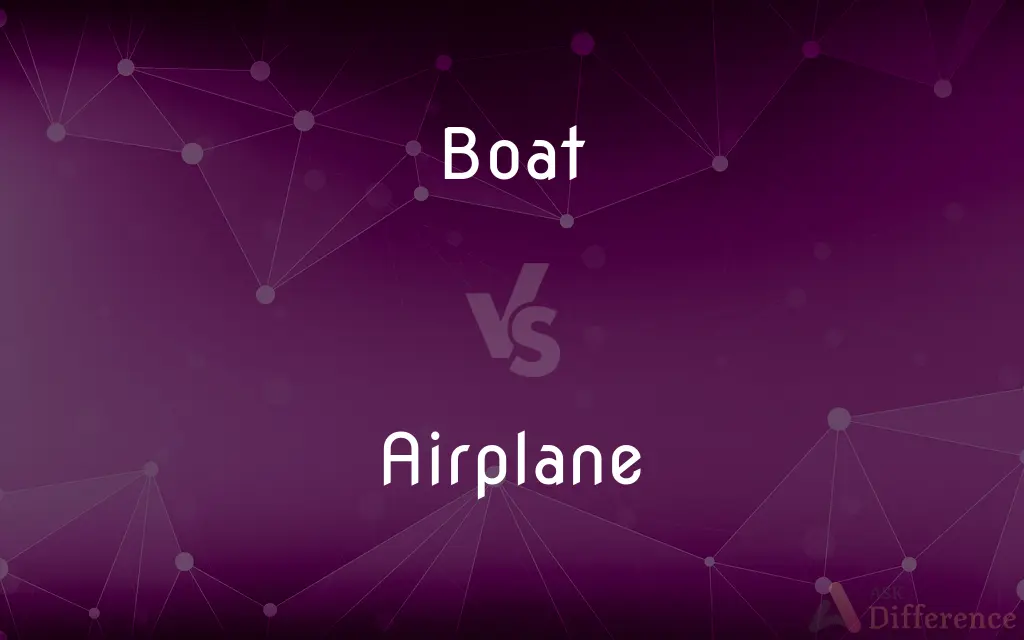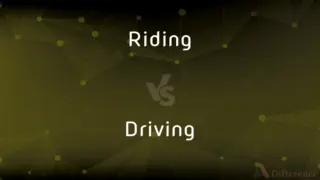Boat vs. Airplane — What's the Difference?
Edited by Tayyaba Rehman — By Fiza Rafique — Updated on April 9, 2024
Boats navigate water by displacing enough water to float, using oars, motors, or sails for propulsion, whereas airplanes fly through the air using lift generated by wings and propulsion from jet engines or propellers.

Difference Between Boat and Airplane
Table of Contents
ADVERTISEMENT
Key Differences
Boats are primarily designed for navigation on water surfaces, from small ponds to vast oceans, utilizing various propulsion methods such as paddles, sails, or engines. Whereas airplanes are engineered to travel through the air, employing aerodynamic shapes for lift and engines for thrust, enabling faster travel over long distances.
Boats range from simple, unpowered crafts like canoes and rowboats, relying on human power, to complex, motorized vessels like yachts and cargo ships, designed for leisure, fishing, transport, or commercial purposes. On the other hand, airplanes include a wide variety of types from small, single-engine propeller planes used for recreational flying to large, multi-engine jet aircraft used for commercial passenger and cargo flights.
In terms of speed and range, boats are generally slower and have a limited range compared to airplanes, making them more suitable for shorter, leisurely journeys or specific tasks like fishing and shipping in navigable waters. Whereas airplanes, with their high speed and long range, are ideal for quickly covering vast distances, making air travel the preferred choice for long-distance and international travel.
The operational environment of boats is limited to water bodies, requiring ports, docks, or marinas for boarding, disembarking, and storage. On the other hand, airplanes operate in the aerial environment and require airports with runways, terminals, and control towers to manage takeoffs, landings, and passenger services.
The experience of traveling by boat varies significantly from that of an airplane; boating can offer a more leisurely and scenic journey, often with the ability to navigate at one’s own pace and explore different waterways. Airplane travel, however, is focused on efficiency and speed, offering a faster but more regulated and less scenic travel experience.
ADVERTISEMENT
Comparison Chart
Medium of Travel
Water
Air
Propulsion
Oars, sails, engines
Jet engines, propellers
Speed
Generally slower
Faster
Range
Limited by navigable waters
Vast, can cover continents
Uses
Recreation, transport, fishing, shipping
Passenger and cargo flights, recreation
Compare with Definitions
Boat
Can be propelled by sails, oars, or motors.
They used oars to quietly approach the dock.
Airplane
A powered flying vehicle with fixed wings and a weight greater than that of the air it displaces.
The airplane took off just as the sun was rising.
Boat
Varieties range from small rowboats to large yachts and cargo ships.
Luxury yachts are often seen as a symbol of wealth.
Airplane
Operates from airports that facilitate takeoffs and landings.
The city's airport accommodates international flights.
Boat
A watercraft of any size designed to float or plane, to provide passage across water.
The boat sailed smoothly across the lake.
Airplane
Used for transporting passengers and goods over considerable distances at high speeds.
The cargo airplane carried supplies overseas.
Boat
Often used for leisure activities, transportation, or commercial purposes.
We rented a boat for a day of fishing.
Airplane
Categories include commercial, military, and private aircraft.
Private aircraft offer a more exclusive travel experience.
Boat
Requires navigable water like rivers, lakes, or oceans.
The new boat was perfect for the shallow river.
Airplane
Employs aerodynamics for lift and engines for propulsion.
The jet engine’s roar is thrilling at takeoff.
Boat
A boat is a watercraft of a large range of types and sizes, but generally smaller than a ship, which is distinguished by its larger size, shape, cargo or passenger capacity, or its ability to carry boats. Small boats are typically found on inland waterways such as rivers and lakes, or in protected coastal areas.
Airplane
An airplane or aeroplane (informally plane) is a fixed-wing aircraft that is propelled forward by thrust from a jet engine, propeller, or rocket engine. Airplanes come in a variety of sizes, shapes, and wing configurations.
Boat
A relatively small, usually open craft of a size that might be carried aboard a ship.
Airplane
A powered flying vehicle with fixed wings and a weight greater than that of the air it displaces; an aeroplane.
Boat
An inland vessel of any size.
Airplane
Any of various winged vehicles capable of flight, generally heavier than air and driven by jet engines or propellers.
Boat
A ship or submarine.
Airplane
A powered heavier-than-air aircraft with fixed wings.
Boat
A dish shaped like a boat
A sauce boat.
Airplane
(intransitive) To fly in an aeroplane.
Boat
To travel by boat.
Airplane
(transitive) To transport by aeroplane.
Boat
To ride a boat for pleasure.
Airplane
A heavier-than-air aircraft. Same as aeroplane{2}.
Boat
To transport by boat.
Airplane
An aircraft that has a fixed wing and is powered by propellers or jets;
The flight was delayed due to trouble with the airplane
Boat
To place in a boat.
Boat
A craft used for transportation of goods, fishing, racing, recreational cruising, or military use on or in the water, propelled by oars or outboard motor or inboard motor or by wind.
Boat
(poker slang) A full house.
Boat
A vehicle, utensil, or dish somewhat resembling a boat in shape.
A stone boat;
A gravy boat
Boat
(chemistry) One of two possible conformations of cyclohexane rings (the other being chair), shaped roughly like a boat.
Boat
The refugee boats arriving in Australian waters, and by extension, refugees generally.
Boat
(intransitive) To travel by boat.
Boat
(transitive) To transport in a boat.
To boat goods
Boat
(transitive) To place in a boat.
To boat oars
Boat
A small open vessel, or water craft, usually moved by cars or paddles, but often by a sail.
Boat
Hence, any vessel; usually with some epithet descriptive of its use or mode of propulsion; as, pilot boat, packet boat, passage boat, advice boat, etc. The term is sometimes applied to steam vessels, even of the largest class; as, the Cunard boats.
Boat
A vehicle, utensil, or dish, somewhat resembling a boat in shape; as, a stone boat; a gravy boat.
Boat
To transport in a boat; as, to boat goods.
Boat
To place in a boat; as, to boat oars.
Boat
To go or row in a boat.
I boated over, ran my craft aground.
Boat
A small vessel for travel on water
Boat
A dish (often boat-shaped) for serving gravy or sauce
Boat
Ride in a boat on water
Common Curiosities
Are airplanes safer than boats?
Both modes of transport are very safe with their safety records improving over time; the perceived safety can depend on specific conditions and scenarios.
Can boats travel as fast as airplanes?
Generally, no. Airplanes can travel much faster than boats due to their aerodynamic designs and powerful engines.
What defines a boat?
A boat is defined as a watercraft of any size designed to float on and move across water, either by being propelled by wind, oars, or engines.
Why are boats used instead of airplanes for certain tasks?
Boats are used for tasks requiring water navigation, like fishing, leisure sailing, or transporting goods over water, where speed is not the primary concern.
Why are airplanes preferred for international travel?
Due to their speed and ability to cover vast distances quickly, airplanes are preferred for saving time on international journeys.
What are the environmental impacts of boats and airplanes?
Both have environmental impacts, including emissions and noise; however, airplanes typically have a higher carbon footprint per passenger mile compared to boats.
What’s the main advantage of air travel over sea travel?
The main advantage is speed; air travel allows for quicker transportation over long distances compared to sea travel.
How do airplanes fly?
Airplanes fly by generating lift with their wings, which is greater than their weight, propelled forward by engines.
Do airplanes require water for operation?
No, airplanes do not require water; they take off and land on runways at airports.
How do the propulsion systems of boats and airplanes differ?
Boats use oars, sails, or engines that push against the water, while airplanes use jet engines or propellers that push against the air.
Can boats operate on any water body?
Boats can operate on most navigable waters, but their size and design might limit where they can go, such as shallow waters or small lakes.
What type of boat is capable of crossing oceans?
Ocean-going vessels like sailboats, yachts, and cargo ships are designed to cross oceans.
How does the design of boats and airplanes reflect their purposes?
Boat designs optimize for buoyancy and stability in water, while airplane designs focus on aerodynamics for flight efficiency and speed.
Can airplanes land on water?
Certain airplanes, known as seaplanes, can take off and land on water, but most airplanes require a runway.
What historical developments have influenced modern boats and airplanes?
Innovations in engineering, navigation, and materials have advanced both, with boats evolving from simple rafts to sophisticated ships and airplanes from gliders to jet aircraft.
Share Your Discovery

Previous Comparison
Riding vs. Driving
Next Comparison
Cave vs. CoveAuthor Spotlight
Written by
Fiza RafiqueFiza Rafique is a skilled content writer at AskDifference.com, where she meticulously refines and enhances written pieces. Drawing from her vast editorial expertise, Fiza ensures clarity, accuracy, and precision in every article. Passionate about language, she continually seeks to elevate the quality of content for readers worldwide.
Edited by
Tayyaba RehmanTayyaba Rehman is a distinguished writer, currently serving as a primary contributor to askdifference.com. As a researcher in semantics and etymology, Tayyaba's passion for the complexity of languages and their distinctions has found a perfect home on the platform. Tayyaba delves into the intricacies of language, distinguishing between commonly confused words and phrases, thereby providing clarity for readers worldwide.
















































